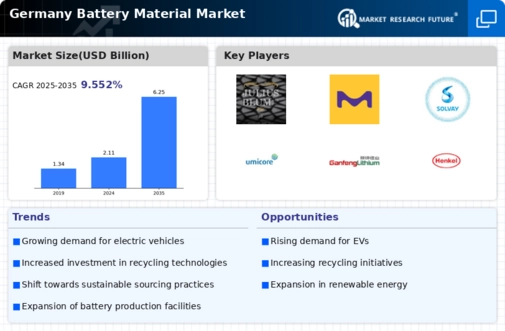The battery material market in Germany is characterized by a dynamic competitive landscape, driven by increasing demand for electric vehicles (EVs) and renewable energy storage solutions. Key players such as BASF SE (DE), Umicore SA (BE), and Varta AG (DE) are strategically positioned to leverage innovation and sustainability in their operations. BASF SE (DE) focuses on developing advanced battery materials, while Umicore SA (BE) emphasizes recycling and sustainable sourcing of raw materials. Varta AG (DE) is enhancing its production capabilities to meet the growing demand for compact battery solutions, particularly in consumer electronics and automotive applications. Collectively, these strategies contribute to a competitive environment that prioritizes technological advancement and environmental responsibility.
In terms of business tactics, companies are increasingly localizing manufacturing to reduce supply chain vulnerabilities and enhance responsiveness to market demands. The market structure appears moderately fragmented, with several players vying for market share, yet dominated by a few key firms that exert considerable influence. This competitive structure fosters innovation as companies strive to differentiate themselves through unique offerings and operational efficiencies.
In November 2025, BASF SE (DE) announced a partnership with a leading automotive manufacturer to develop next-generation battery materials aimed at improving energy density and reducing costs. This collaboration is strategically significant as it aligns with the growing trend towards electrification in the automotive sector, potentially positioning BASF as a leader in high-performance battery solutions.
In October 2025, Umicore SA (BE) unveiled a new recycling facility in Germany, designed to recover valuable metals from spent batteries. This initiative not only enhances Umicore's sustainability profile but also addresses the increasing regulatory pressures for responsible waste management in the battery sector. The facility is expected to significantly boost the company's capacity to supply recycled materials, thereby reducing reliance on virgin resources.
In September 2025, Varta AG (DE) expanded its production facility in Germany to increase output of lithium-ion batteries. This expansion is crucial as it responds to the surging demand for batteries in both the automotive and consumer electronics markets. By enhancing production capabilities, Varta aims to solidify its market position and cater to the evolving needs of its customers.
As of December 2025, current competitive trends in the battery material market include a strong emphasis on digitalization, sustainability, and the integration of artificial intelligence (AI) in manufacturing processes. Strategic alliances are increasingly shaping the landscape, enabling companies to pool resources and expertise to drive innovation. Looking ahead, competitive differentiation is likely to evolve from traditional price-based competition towards a focus on technological innovation, supply chain reliability, and sustainable practices. This shift underscores the importance of adaptability and forward-thinking strategies in navigating the complexities of the battery material market.

























Leave a Comment